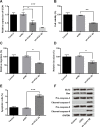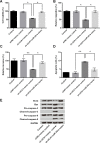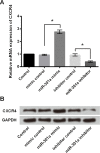Knockdown of Urothelial Carcinoma-Associated 1 Suppressed Cell Growth and Migration Through Regulating miR-301a and CXCR4 in Osteosarcoma MHCC97 Cells
- PMID: 29523218
- PMCID: PMC7848290
- DOI: 10.3727/096504018X15201143705855
Knockdown of Urothelial Carcinoma-Associated 1 Suppressed Cell Growth and Migration Through Regulating miR-301a and CXCR4 in Osteosarcoma MHCC97 Cells
Retraction in
-
Retraction: Knockdown of Urothelial Carcinoma-Associated 1 Suppressed Cell Growth and Migration Through Regulating miR-301a and CXCR4 in Osteosarcoma MHCC97 Cells.Oncol Res. 2024 Jul 17;32(8):1381. doi: 10.32604/or.2024.055035. eCollection 2024. Oncol Res. 2024. PMID: 39055891 Free PMC article.
Abstract
Liver cancer is one of the most common malignancies in the world and a leading cause of cancer-related mortality. Accumulating evidence has highlighted the critical role of long noncoding RNAs (lncRNAs) in various cancers. The present study aimed to explore the role of lncRNA urothelial carcinoma-associated 1 (UCA1) in cell growth and migration in MHCC97 cells and its underlying mechanism. First, we assessed the expression of UCA1 in MHCC97 and three other cell lines by RT-qPCR. Then the expression of UCA1, miR-301a, and CXCR4 in MHCC97 cells was altered by transient transfection. The effects of UCA1 and miR-301 on cell viability, migration, invasion, and apoptosis were assessed. The results revealed that UCA1 expression was relatively higher in MHCC97 cells than in MG63, hFOB1.19, and OS-732 cells. Knockdown of UCA1 reduced cell viability, inhibited migration and invasion, and promoted cell apoptosis. However, the effect of UCA1 knockdown on cell growth and migration was blocked by miR-301a overexpression, whose expression was regulated by UCA1. We also found that miR-301a positively regulated CXCR4 expression. CXCR4 inhibition reversed the effect of miR-301a overexpression on cell growth and migration. Moreover, miR-301a activated the Wnt/β-catenin and NF-κB pathways via regulating CXCR4. The present study demonstrated that UCA1 inhibition exerted an antigrowth and antimigration role in MHCC97 cells through regulating miR-301a and CXCR4 expression.
Conflict of interest statement
The authors declare no conflicts of interest.
Figures







Similar articles
-
Long Non-Coding RNA Urothelial Carcinoma Associated 1 Promotes Proliferation, Migration and Invasion of Osteosarcoma Cells by Regulating microRNA-182.Cell Physiol Biochem. 2018;51(3):1149-1163. doi: 10.1159/000495493. Epub 2018 Nov 27. Cell Physiol Biochem. 2018. Retraction in: Cell Physiol Biochem. 2020;54(5):1099. doi: 10.33594/000000301. PMID: 30481751 Retracted.
-
Knockdown of long noncoding RNA urothelial carcinoma-associated 1 inhibits cell viability, migration, and invasion by regulating microRNA-182 in gastric carcinoma.J Cell Biochem. 2018 Dec;119(12):10075-10086. doi: 10.1002/jcb.27344. Epub 2018 Aug 20. J Cell Biochem. 2018. Retraction in: J Cell Biochem. 2021 Jul;122(7):772. doi: 10.1002/jcb.29931. PMID: 30129054 Retracted.
-
LncRNA UCA1 acts as a sponge of miR-204 to up-regulate CXCR4 expression and promote prostate cancer progression.Biosci Rep. 2019 May 2;39(5):BSR20181465. doi: 10.1042/BSR20181465. Print 2019 May 31. Biosci Rep. 2019. PMID: 30940776 Free PMC article.
-
Knockdown of lncRNA-UCA1 inhibits cell viability and migration of human glioma cells by miR-193a-mediated downregulation of CDK6.J Cell Biochem. 2019 Sep;120(9):15157-15169. doi: 10.1002/jcb.28777. Epub 2019 May 20. J Cell Biochem. 2019. Retraction in: J Cell Biochem. 2021 Nov;122 Suppl 1:S44. doi: 10.1002/jcb.30003. PMID: 31111564 Retracted.
-
Multifaceted role of microRNA-301a in human cancer: from biomarker potential to therapeutic targeting.Cancer Gene Ther. 2024 Dec;31(12):1754-1764. doi: 10.1038/s41417-024-00832-1. Epub 2024 Sep 24. Cancer Gene Ther. 2024. PMID: 39317714 Review.
Cited by
-
Emerging roles of long non-coding RNAs in osteosarcoma.Front Mol Biosci. 2024 Mar 7;11:1327459. doi: 10.3389/fmolb.2024.1327459. eCollection 2024. Front Mol Biosci. 2024. PMID: 38516191 Free PMC article. Review.
-
Regulatory role of long non-coding RNA UCA1 in signaling pathways and its clinical applications.Oncol Lett. 2021 May;21(5):404. doi: 10.3892/ol.2021.12665. Epub 2021 Mar 19. Oncol Lett. 2021. PMID: 33777227 Free PMC article. Review.
-
The role of CXCR4 in multiple myeloma: Cells' journey from bone marrow to beyond.J Bone Oncol. 2019 Jul 16;17:100253. doi: 10.1016/j.jbo.2019.100253. eCollection 2019 Aug. J Bone Oncol. 2019. PMID: 31372333 Free PMC article. Review.
-
The prognostic value and mechanisms of lncRNA UCA1 in human cancer.Cancer Manag Res. 2019 Aug 14;11:7685-7696. doi: 10.2147/CMAR.S200436. eCollection 2019. Cancer Manag Res. 2019. PMID: 31616184 Free PMC article. Review.
-
Functional interplay between long non-coding RNAs and the Wnt signaling cascade in osteosarcoma.Cancer Cell Int. 2021 Jun 15;21(1):313. doi: 10.1186/s12935-021-02013-8. Cancer Cell Int. 2021. PMID: 34130697 Free PMC article. Review.
References
-
- Wray CJ, Harvin JA, Silberfein EJ, Ko TC, Kao LS. Pilot prognostic model of extremely poor survival among high-risk hepatocellular carcinoma patients. Cancer 2012;118(24):6118–25. - PubMed
Publication types
MeSH terms
Substances
LinkOut - more resources
Full Text Sources
Other Literature Sources
